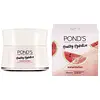What's inside
What's inside
 Key Ingredients
Key Ingredients

No key ingredients
 Benefits
Benefits

 Concerns
Concerns

 Ingredients Side-by-side
Ingredients Side-by-side

Water
Skin ConditioningDimethicone
EmollientGlycerin
HumectantPanthenol
Skin ConditioningHexylene Glycol
EmulsifyingPhenoxyethanol
PreservativeCarbomer
Emulsion StabilisingSodium Hydroxide
BufferingPentylene Glycol
Skin ConditioningDisodium EDTA
Propylene Glycol
HumectantEthylhexylglycerin
Skin ConditioningAloe Barbadensis Extract
Skin Conditioning4-T-Butylcyclohexanol
MaskingPEG-40 Hydrogenated Castor Oil
EmulsifyingTrideceth-9
EmulsifyingCitric Acid
BufferingHydroxyphenyl Propamidobenzoic Acid
Skin ConditioningLavandula Angustifolia Flower/Leaf/Stem Extract
MaskingBisabolol
MaskingWater, Dimethicone, Glycerin, Panthenol, Hexylene Glycol, Phenoxyethanol, Carbomer, Sodium Hydroxide, Pentylene Glycol, Disodium EDTA, Propylene Glycol, Ethylhexylglycerin, Aloe Barbadensis Extract, 4-T-Butylcyclohexanol, PEG-40 Hydrogenated Castor Oil, Trideceth-9, Citric Acid, Hydroxyphenyl Propamidobenzoic Acid, Lavandula Angustifolia Flower/Leaf/Stem Extract, Bisabolol
Water
Skin ConditioningDimethicone
EmollientGlycerin
HumectantButylene Glycol
HumectantAmmonium Acryloyldimethyltaurate/Vp Copolymer
Isohexadecane
EmollientDimethicone/Vinyl Dimethicone Crosspolymer
Skin ConditioningCaprylic/Capric Triglyceride
MaskingCitrullus Lanatus Fruit Extract
Skin ConditioningTocopheryl Acetate
AntioxidantAmmonium Acryloyldimethyltaurate/Beheneth-25 Methacrylate Crosspolymer
Emulsion StabilisingCetearyl Alcohol
EmollientBenzophenone-4
UV AbsorberAllantoin
Skin ConditioningLinoleamidopropyl Pg-Dimonium Chloride Phosphate
Propylene Glycol
HumectantStearic Acid
CleansingParfum
MaskingNiacinamide
SmoothingDimethiconol
EmollientCetearyl Glucoside
EmulsifyingDisodium EDTA
Sodium PCA
HumectantBHT
AntioxidantPropanediol
SolventC12-14 Pareth-12
EmulsifyingT-Butyl Alcohol
PerfumingSodium Hydroxide
BufferingPEG-4 Laurate
EmulsifyingPEG-4 Dilaurate
EmulsifyingPhenoxyethanol
PreservativeHydroxystearic Acid
CleansingPEG-4
HumectantIodopropynyl Butylcarbamate
PreservativeBenzoic Acid
MaskingMethylparaben
PreservativeChlorphenesin
AntimicrobialGlucose
HumectantSodium Ascorbyl Phosphate
AntioxidantSodium Carbonate
BufferingCyclotetrasiloxane
EmollientPalmitic Acid
EmollientArachidic Acid
CleansingSodium Chloride
MaskingSodium Sulfate
CI 14700
Cosmetic ColorantWater, Dimethicone, Glycerin, Butylene Glycol, Ammonium Acryloyldimethyltaurate/Vp Copolymer, Isohexadecane, Dimethicone/Vinyl Dimethicone Crosspolymer, Caprylic/Capric Triglyceride, Citrullus Lanatus Fruit Extract, Tocopheryl Acetate, Ammonium Acryloyldimethyltaurate/Beheneth-25 Methacrylate Crosspolymer, Cetearyl Alcohol, Benzophenone-4, Allantoin, Linoleamidopropyl Pg-Dimonium Chloride Phosphate, Propylene Glycol, Stearic Acid, Parfum, Niacinamide, Dimethiconol, Cetearyl Glucoside, Disodium EDTA, Sodium PCA, BHT, Propanediol, C12-14 Pareth-12, T-Butyl Alcohol, Sodium Hydroxide, PEG-4 Laurate, PEG-4 Dilaurate, Phenoxyethanol, Hydroxystearic Acid, PEG-4, Iodopropynyl Butylcarbamate, Benzoic Acid, Methylparaben, Chlorphenesin, Glucose, Sodium Ascorbyl Phosphate, Sodium Carbonate, Cyclotetrasiloxane, Palmitic Acid, Arachidic Acid, Sodium Chloride, Sodium Sulfate, CI 14700
 Reviews
Reviews

Ingredients Explained
These ingredients are found in both products.
Ingredients higher up in an ingredient list are typically present in a larger amount.
Dimethicone is a type of synthetic silicone created from natural materials such as quartz.
What it does:
Dimethicone comes in different viscosities:
Depending on the viscosity, dimethicone has different properties.
Ingredients lists don't always show which type is used, so we recommend reaching out to the brand if you have questions about the viscosity.
This ingredient is unlikely to cause irritation because it does not get absorbed into skin. However, people with silicone allergies should be careful about using this ingredient.
Note: Dimethicone may contribute to pilling. This is because it is not oil or water soluble, so pilling may occur when layered with products. When mixed with heavy oils in a formula, the outcome is also quite greasy.
Learn more about DimethiconeDisodium EDTA plays a role in making products more stable by aiding other preservatives.
It is a chelating agent, meaning it neutralizes metal ions that may be found in a product.
Disodium EDTA is a salt of edetic acid and is found to be safe in cosmetic ingredients.
Learn more about Disodium EDTAGlycerin is already naturally found in your skin. It helps moisturize and protect your skin.
A study from 2016 found glycerin to be more effective as a humectant than AHAs and hyaluronic acid.
As a humectant, it helps the skin stay hydrated by pulling moisture to your skin. The low molecular weight of glycerin allows it to pull moisture into the deeper layers of your skin.
Hydrated skin improves your skin barrier; Your skin barrier helps protect against irritants and bacteria.
Glycerin has also been found to have antimicrobial and antiviral properties. Due to these properties, glycerin is often used in wound and burn treatments.
In cosmetics, glycerin is usually derived from plants such as soybean or palm. However, it can also be sourced from animals, such as tallow or animal fat.
This ingredient is organic, colorless, odorless, and non-toxic.
Glycerin is the name for this ingredient in American English. British English uses Glycerol/Glycerine.
Learn more about GlycerinPhenoxyethanol is a preservative that has germicide, antimicrobial, and aromatic properties. Studies show that phenoxyethanol can prevent microbial growth. By itself, it has a scent that is similar to that of a rose.
It's often used in formulations along with Caprylyl Glycol to preserve the shelf life of products.
Propylene Glycol is an odorless, colorless liquid. As a humectant, it helps skin retain moisture. It also aids in delivering active ingredients.
Another role of this ingredient is preventing a product from melting or freezing. Propylene glycol also adds antimicrobrial properties to a product, elongating product lifespan.
This ingredient is considered an organic alcohol and commonly added into both cosmetics and foods.
Those with sensitive skin or conditions may develop a rash when using this ingredient.
Learn more about Propylene GlycolSodium Hydroxide is also known as lye or caustic soda. It is used to adjust the pH of products; many ingredients require a specific pH to be effective.
In small amounts, sodium hydroxide is considered safe to use. However, large amounts may cause chemical burns due to its high alkaline.
Your skin has a natural pH and acid mantle. This acid mantle helps prevent harmful bacteria from breaking through. The acid mantle also helps keep your skin hydrated.
"Alkaline" refers to a high pH level. A low pH level would be considered acidic.
Learn more about Sodium HydroxideWater. It's the most common cosmetic ingredient of all. You'll usually see it at the top of ingredient lists, meaning that it makes up the largest part of the product.
So why is it so popular? Water most often acts as a solvent - this means that it helps dissolve other ingredients into the formulation.
You'll also recognize water as that liquid we all need to stay alive. If you see this, drink a glass of water. Stay hydrated!
Learn more about Water